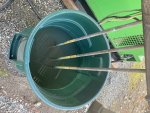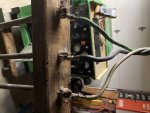Summerpaws
Active member
- 37
- 110
- 33
- Location
- Hampton, NH
First, before I get to my question, let me tell you a bit about myself. I am a retired mechanic/stationary engineer. I retired from a large manufacturing company (1 million square feet). The company was founded and owned by a gentleman who was an officer on a carrier in the Navy. His dream was to build a company that was isolated from any utilities. That meant it had a power plant, wells, LNG and propane and diesel storage. When I started there in 1982, the power came from 4 Caterpillar 399 750kw co-gen generators and 2 398 500kw co-gens. Shortly after that we added a 2mw Fairbanks Morse OP gas/diesel co-gen unit. In 2000 we got rid of the FM and added the first 5mw Solar gas turbine (also co-gen) with plans to add a 2nd in 10 years.
Our goal was to keep each generator at 100% load. Obviously they were most efficient there as well as providing the most heat for the low pressure steam boilers that the exhaust ran. Obviously that wasn't as critical when we got the gas turbine but we still wanted at least 50% load on it. My job was to operate the plant in the most efficient manner by adding or dropping generators and in some cases, load shedding.
I knew about wet stacking of course, but I never saw it.
Now, my situation. I have a MEP 802a. It is wired into the house with the use of an interlock. I have done a lot of testing to see what my house draws for power. I chose the 5kw 802 because it would be much easier to load it appropriately even though I could easily overload it if the power demands were not controlled.
On a normal day, the house draws roughly 750w. That is my 120 volt load. I have sump pumps and in the summer, a/c, but that only adds maybe 1000 to 1200 watts. The sump pumps cycle maybe 5 times an hour for less than a minute each time.
My wife does a load of laundry once a day. Our dryer uses close to 3000 watts. I have an electric water heater (4500 watts). Stove and oven are the only other high loads. Obviously I manage the load and usually leave the 230 volt breakers off with the exception of the stove/oven.
Let's say we have a small 4 hour outage. No load on the genny higher than 1750 to 2000 watts. That is my usual outage. How many of these small outages do I have to have before it's necessary to load up the genset and clean it out? I have read through over 200 pages of this forum and it seems that most folk do a run with a load bank every 3 months or so. I want to set up a schedule to run at 100% for a couple of hours but I am not sure how often I should do it.
I usually lose power 4 or 5 times a year, usually for the afore mentioned 3 or 4 hours. I live next to a swamp in a 200 year old farmhouse and I cannot go without power for more than an hour due to the amount of water that pours into my dirt floor basement. Right now, with all the rain we have had (and 3 sump pumps running), more like 1/2 hour.
How long does it take to start wet stacking? I know it's cumulative, but how many hours with a light load until there is performance limiting carbon buildup?
Our goal was to keep each generator at 100% load. Obviously they were most efficient there as well as providing the most heat for the low pressure steam boilers that the exhaust ran. Obviously that wasn't as critical when we got the gas turbine but we still wanted at least 50% load on it. My job was to operate the plant in the most efficient manner by adding or dropping generators and in some cases, load shedding.
I knew about wet stacking of course, but I never saw it.
Now, my situation. I have a MEP 802a. It is wired into the house with the use of an interlock. I have done a lot of testing to see what my house draws for power. I chose the 5kw 802 because it would be much easier to load it appropriately even though I could easily overload it if the power demands were not controlled.
On a normal day, the house draws roughly 750w. That is my 120 volt load. I have sump pumps and in the summer, a/c, but that only adds maybe 1000 to 1200 watts. The sump pumps cycle maybe 5 times an hour for less than a minute each time.
My wife does a load of laundry once a day. Our dryer uses close to 3000 watts. I have an electric water heater (4500 watts). Stove and oven are the only other high loads. Obviously I manage the load and usually leave the 230 volt breakers off with the exception of the stove/oven.
Let's say we have a small 4 hour outage. No load on the genny higher than 1750 to 2000 watts. That is my usual outage. How many of these small outages do I have to have before it's necessary to load up the genset and clean it out? I have read through over 200 pages of this forum and it seems that most folk do a run with a load bank every 3 months or so. I want to set up a schedule to run at 100% for a couple of hours but I am not sure how often I should do it.
I usually lose power 4 or 5 times a year, usually for the afore mentioned 3 or 4 hours. I live next to a swamp in a 200 year old farmhouse and I cannot go without power for more than an hour due to the amount of water that pours into my dirt floor basement. Right now, with all the rain we have had (and 3 sump pumps running), more like 1/2 hour.
How long does it take to start wet stacking? I know it's cumulative, but how many hours with a light load until there is performance limiting carbon buildup?





